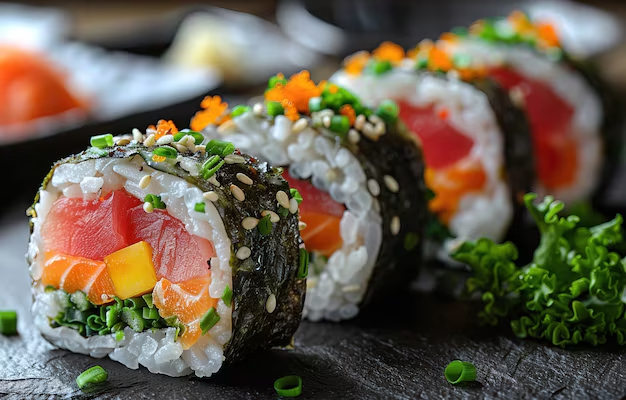Sushi rolls represent a delightful marriage of time-honored techniques and innovative culinary artistry. From their humble beginnings as a method of preserving fish to their current status as a global culinary phenomenon, sushi rolls have continuously evolved, adapting to local tastes and preferences while staying true to their Japanese roots. This article explores the captivating history, evolution, and modern trends of sushi rolls, highlighting their enduring appeal and the creative spirit that drives their ongoing transformation.
The Ancient Origins of Sushi
The story of sushi begins in ancient Southeast Asia, where people discovered that salted rice could be used to preserve fish. This early form of sushi, known as narezushi, involved fermenting fish with rice and salt, a process that could take several months. The rice was discarded, and only the preserved fish was consumed.Over time, this preservation technique spread to Japan, where it underwent significant changes. During the Muromachi period (1336–1573), people began to eat the rice along with the fish. In the Edo period (1603–1867), vinegar was added to the rice instead of relying solely on fermentation. This innovation not only accelerated the process but also improved the flavor of the sushi.
The Birth of Modern Sushi

The creation of modern sushi is often attributed to Hanaya Yohei, who, in the 1820s, invented nigiri-zushi. This new style of sushi consisted of a small, hand-pressed mound of vinegared rice topped with a slice of fresh fish. Nigiri-zushi quickly became popular in Edo (modern-day Tokyo) as a convenient and affordable fast food.
The Emergence of Sushi Rolls
While nigiri gained widespread popularity, chefs continued to experiment with new ways to present and enjoy sushi. In the 20th century, sushi rolls, also known as makizushi, began to emerge. These rolls involved spreading vinegared rice and various fillings onto a sheet of nori (dried seaweed), then rolling it up using a bamboo mat called a makisu. The roll was then sliced into bite-sized pieces, creating a visually appealing and easy-to-eat dish.
The California Roll and Global Expansion
One of the most significant milestones in the history of sushi rolls was the creation of the California roll in the early 1970s. Invented by a Japanese chef in Los Angeles, the California roll was designed to appeal to Western palates by using avocado instead of raw fish. Its popularity quickly spread, and it became a gateway for many people to discover and enjoy sushi.As sushi gained international recognition, chefs around the world began to incorporate local ingredients and flavors into their sushi rolls. This led to a diverse range of creative and innovative rolls, such as those incorporating spicy sauces, tempura, cream cheese, and various types of seafood and vegetables.
Commercialization and Resurgence of Authenticity

The commercialization of sushi in the 1980s brought sushi rolls to a wider audience. Automated processes allowed companies to mass-produce sushi rolls at a lower cost, making them available in supermarkets and convenience stores. However, this also led to a decline in the quality and authenticity of sushi.In recent years, there has been a resurgence of demand for fresh, authentic sushi prepared by skilled chefs. Many people have come to appreciate the difference between mass-produced sushi and the artistry of a true sushi master. This has led to the growth of high-end sushi restaurants that focus on using the finest ingredients and traditional techniques.
Modern Trends in Sushi Rolls
Today, sushi rolls continue to evolve, with chefs pushing the boundaries of creativity and innovation. Some popular trends in modern sushi rolls include:
- Fusion Rolls: Combining elements from different cuisines, such as Mexican, Italian, or Korean, to create unique and exciting flavor combinations.
- Vegetarian and Vegan Rolls: Using a variety of vegetables, fruits, and plant-based proteins to create delicious and satisfying sushi rolls for those who don’t eat meat or fish.
- Sushi Burritos and Bowls: Deconstructing the traditional sushi roll into a larger, more portable format, or serving the ingredients in a bowl for a customizable and casual dining experience.
- Sustainable Sushi: Focusing on using sustainably sourced seafood and eco-friendly practices to minimize the environmental impact of sushi consumption.
The Enduring Appeal of Sushi Rolls

Sushi rolls have come a long way from their humble beginnings as a method of preserving fish. Today, they are a global culinary sensation, enjoyed by people of all ages and backgrounds. Their enduring appeal lies in their versatility, visual appeal, and the endless possibilities for creative expression. Whether you prefer a classic California roll or a daring fusion creation, there’s a sushi roll out there for everyone to enjoy.
Also Read : How To Prepare Classic Italian Pasta Dishes
Conclusion
The journey of sushi rolls from ancient preservation techniques to modern culinary art is a testament to human ingenuity and adaptability. As sushi continues to evolve, it remains a delicious fusion of tradition and creativity, captivating taste buds and inspiring chefs around the world.
Frequently Asked Questions (FAQs)
What is the origin of sushi rolls?
Sushi rolls originated in Southeast Asia as a method of preserving fish using fermented rice. This technique spread to Japan and evolved over centuries into the sushi we know today.
Who invented the modern sushi roll?
While the exact inventor of the sushi roll is unknown, the California roll, created in Los Angeles in the early 1970s, played a significant role in popularizing sushi rolls worldwide.
What are the basic ingredients of a sushi roll?
The basic ingredients of a sushi roll include vinegared rice, nori (dried seaweed), and a variety of fillings such as fish, vegetables, and sauces.
How has sushi evolved over time?
Sushi has evolved from a simple fish preservation technique to a global culinary art form, with chefs constantly innovating and incorporating new ingredients and flavors.
What are some popular modern sushi roll trends?
Some popular modern sushi roll trends include fusion rolls, vegetarian and vegan rolls, sushi burritos and bowls, and sustainable sushi.

